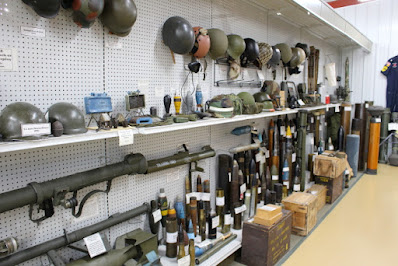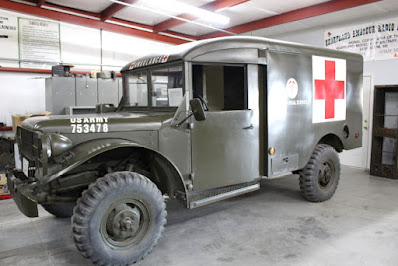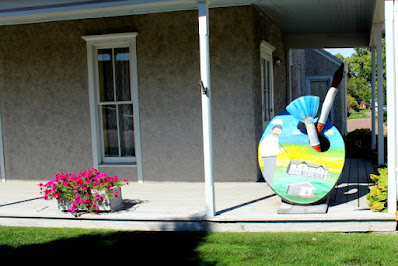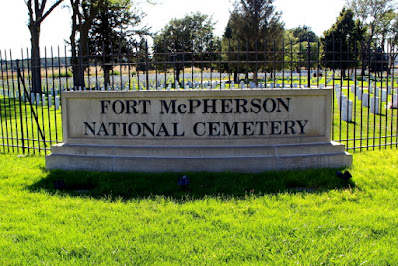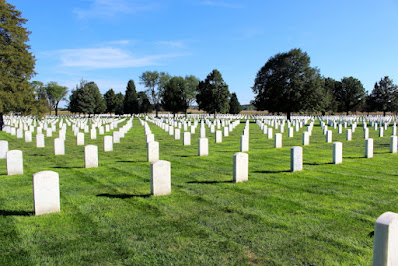Inside of the museum are displays of weapons, uniforms, equipment and a large number of military vehicles from all branches of the service.
When I saw the old "Cracker Box" field ambulance it brought back some memories. (I don't know how or why the vehicle got the name "Cracker Box")
When I was stationed at Ellsworth Air Force Base, I was one of the few people in our Unit that had a Top Secret security clearance. This allowed me to travel out to the Minuteman Missile sites when necessary.
I remember on one occasion I had to make a missile site trip and the Motor Pool gave me a "Cracker Box" to drive. Apparently, they wanted to get rid of the vehicle, but they could not take it out of service until it had a certain number of miles on it. Since I was not in a hurry, I said that I would drive the vehicle. Recommended top speed was 45 miles-per-hour and the missile site was about 60 miles away.
Driving the vehicle was a real challenge. All of the tires were out of balance and the steering was loose and had so much play that the vehicle wandered all over the road. Then of course, there was the road noise and exhaust that kept leaking into the cab. After about an hour I concluded that 45 MPH was just a "recommended" speed, so I decided to see if I could get it up to at least 55 MPH. At that speed, the vibration was really bad and then suddenly there was a loud noise and the back of the vehicle went about two into the air and then came down so hard that everything in the back of the vehicle went flying all over. When I stopped, I found the driveshaft by the side of the road and it was bent in a "J" shape. The front universal joint had broken and the drive shaft had dug into the pavement, lifting the back of the vehicle into the air before braking the real u-joint. Since I was not too far from the missile silo, I just put it in four-wheel drive and drove the rest of the way with front-wheel drive only. It actually drove better, so I drove home the same way.
When I returned the vehicle to the Motor Pool I thought they were going to be upset at the broken driveshaft. Instead, they were thrilled and kept thanking me for the mechanical problem. They said that since the cost of repairs was greater than the value of the vehicle as repaired, they could now send the vehicle to the scrap yard.
Also on display in the museum building was an M3 Bradley, which looks like a tank but is actually a troop support vehicle. Visitors are allowed to sit in the gunner's and driver's seats.
The Dawson County Courthouse in Lexington was quite ornate and there was a veterans memorial and interesting clock in front of the building. Although not in very good condition, there is still a brick street in front of the courthouse
Adjacent to the railroad track just outside of Lexington is a historical marker that tells about a train wreck at this site on August 7, 1867. Several people were killed in the wreck.
The 100th Meridian line is easy to find as it passes through Cozad (population 3,988) because the 100th Meridian Museum building straddles the 100th Meridian line. Geographically, the 100th Meridian line is symbolic of where the West begins and marks the boundary between the semi-arid climate in the West and the humid continental and humid-subtropical climates in Eastern United States.
Located in Gothenburg (population 3,478) is the Sod House Museum that contains the world's largest plow, a sod house, barn museum, and some unusual statues made from barbed wire and scrap metal.
In 1854, Sam Machette built a ranch house and fur trading post that was converted into a Pony Express Station in 1860. The original building was moved to Ehman Park in 1954. Entrance to the building is free and there are docents that are available to answer questions about the Pony Express. The park also contains some modern sculptures, picnic tables, and playground equipment. In 1992, the Nebraska legislature officially designated Gothenburg as the Pony Express Capital of Nebraska.
On February 20, 1866, Fort McPherson was established on the south side of the Platte River at Cottonwood Springs to protect travelers on the Oregon Trail. At the time, this site was the only known spring in the surrounding area. Because of its location, the fort was popularly known as Fort Cottonwood. On June 20, 1880, the fort was disbanded and the site is now a farmer's field. Located along the Lincoln Highway is a statue and information marker identifying the Fort McPherson site.
The 20-acre Fort McPherson National Cemetery is still in use today and has over 10,000 interments.
Steam locomotive #480 was built in 1903 and was used to pull train cars between Grand Island and North Platte. When loaded, the locomotive weighed 320,340 pounds and could hold 7,000 gallons of water and 28,000 pounds of coal. It is now on display in North Platte (population 23,390).
Located northwest of North Platte is Buffalo Bill Ranch State Park (aka Scout's Rest Ranch). William Cody ("Buffalo Bill") initially purchased 160 acres of land in 1878 and over a period of time 4,000 additional acres of land were purchased. Cody sold the ranch in 1911 and in 1964 the house and 25-acres of land were purchased for a Historic State Park.
The 1887 Horse Barn is 148 feet long, 70 feet wide, and 40 feet high. To build the barn required seven railroad cars of lumber.
The Three Sisters Garden at Scouts Rest Ranch is a historic representation of the "Three Sisters" (corn, beans, and squash) that Native American Tribes planted because the three plants thrive together, much like three inseparable sisters. A placard states:
By the time Europeans settlers arrived in America in the early 1600s, the Iroquois had been growing the "Three Sisters" for over three centuries. The vegetable trio sustained the Native Americans both physically and spiritually.Each of the sisters contributes something to the planting. Together, the sisters provide a balanced diet from a single planting.
- As older sisters do, the corn offers the beans necessary support.
- The pole beans, the giving sister, pull nitrogen from the air and bring it to the soil for the benefit of all three sisters.
- As the beans grow through the tangle of squash vines and wind their way up the cornstalks into sunlight, they hold the sisters close together.
- The large leaves of the sprawling squash protect the threesome by creating living mulch that shades the soil, keeping it cool and moist and preventing weeds.
- The prickly squash leaves also keep away racoons and other pests, which don't like to step on them.
Together, the three sisters provide both sustainable soil fertility as well as a healthy died.
The Lincoln County Historical Museum is located just around the corner from Scout's Rest Ranch and is sited on an 8-acres parcel of land. In addition to the museum building, there is an entire village made up of historic structures from the surrounding area.
In 1847 this was a camp location for Mormon pioneers that were traveling from Winter Quarters (near Omaha, Nebraska) to the Great Salt Lake area. While camped here, William Clayton invented a distance measuring device that attached to a wagon wheel and accurately recorded the distance traveled.
Cody Park is the "Old Glory Blowout" site of July 4, 1882. A placard states:
The highlights of the celebration took place at the Isaac Dillon Race Track, located at the site of todays Cody Park. Activities included bronc riding, steer roping, and horse racing, cowboys competed for prizes before a large and appreciative audience. This first "Spectator Rodeo" earned Cody the title, "Father of Rodeo." Many of the events in the Old Glory Blowout are still an important part of modern rodeo.
The success of the "Old Glory Blowout" inspired Cody to organize a traveling western exhibition. New acts, including colorful Indians and a band added to the excitement for spectators. On May 10 1883, a first full dress rehearsal was held at Columbus, Nebraska. On May 19, 1883, a first public appearance of Buffalo Bill's Wild West Exhibition took place at Omaha, Nebraska. In the next three decades the Exhibition would appear before millions of spectators in all 48 states, Canada, and parts of Europe.
Another monument is dedicated to the Native Americans who contributed to the success of the Wild West Exhibition. A placard states:
The Indians made the Exhibition successful, said William F. Cody in answer to many reporters questions. Cody had a very sound basis for this statement. The Indian's performances in their very colorful costumes, dancing, drumming, singing and taking part in simulate attacks that involved screeching and whooping, thrilled millions of spectators in hundreds of cities around the world. The Indian attack on the Deadwood Stage Coach was a crowd favorite and repeated performances were requested many times. After each wild and entertaining performance, spectators were invited to visit the Indian Village set up at each location of the Exhibition. For the first time visitors were able to see how the Indian people lived. the tepees, campfires, women cooking, children playing Indian games and the display of traditional tools and weapons. This gave new insight toward Native American culture. The people of North Platte, site of the birth of the Wild West Exhibition at Cody Park, are deeply grateful to the Native Americans who contributed to North Platte's Western Heritage .
Within the Park are a number of other interesting exhibits to visit. A Railroad Museum contains Union Pacific Challenger #3977. The steam locomotive was build in 1943 to haul freight and passengers at speeds up to 70 mile-per-hour. This is the only locomotive of its class on display in the world.
Throughout the Park and all of North Platte are obelisks that are decorated with tiles painted by children.
I was standing across the street from the Courthouse taking pictures when a woman walked out of the building behind me and said, "Don't you want to take a picture of our building?" So, I turned around and took a picture of the North Platte Area Children's Museum sign.
I was going to have dinner downtown, but I decided that I was probably too old for the Canteen District crowd; so I ended up eating at a Denny's restaurant.







